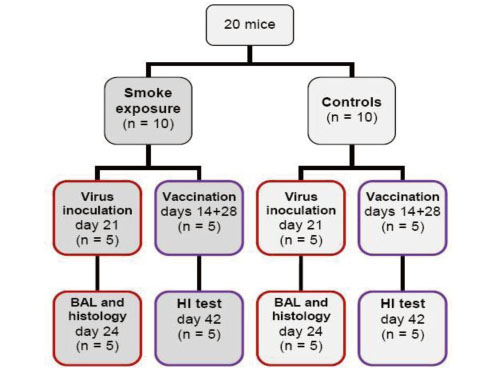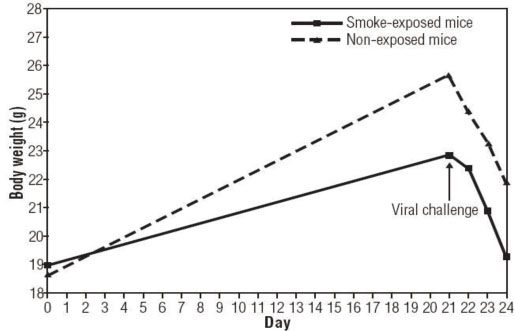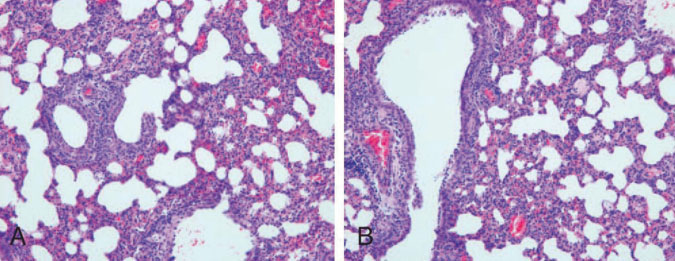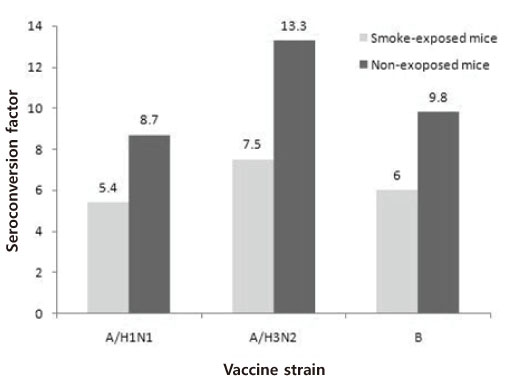Infect Chemother.
2010 Dec;42(6):391-396. 10.3947/ic.2010.42.6.391.
Effect of Smoking on Influenza Illness and Vaccine-induced Immune Response in Mice
- Affiliations
-
- 1Department of Internal Medicine, Inha University College of Medicine, Incheon, Korea.
- 2Department of Internal Medicine, Konkuk University College of Medicine, Chungju, Korea.
- 3Department of Internal Medicine, Korea University College of Medicine, Seoul, Korea. heejinmd@medimail.co.kr
- 4Department of Occupational and Environmental Medicine, Inha University College of Medicine, Incheon, Korea.
- 5Department of Pathology, Inha University College of Medicine, Incheon, Korea.
- KMID: 2170318
- DOI: http://doi.org/10.3947/ic.2010.42.6.391
Abstract
- BACKGROUND
Since cigarette smoking is an important risk factor for respiratory infections and alters the immune response, the severity of influenza illness and the immunogenicity of influenza vaccination may differ between cigarette smokers and non-smokers. This study investigated the effect of cigarette smoke exposure on the severity of influenza illness and vaccine-induced antibody production in mice.
MATERIALS AND METHODS
Cigarette smoke exposed (CE) and non-cigarette smoke exposed (NCE) mice were infected with mouse-adapted influenza A/PR8/8/34 (H1N1). Influenza virus was quantified in bronchoalveolar lavage fluid by real-time polymerase chain reaction and the lung pathology was examined to investigate the influence of smoke exposure on the severity of illness. To assess immunogenicity, hemagglutination inhibition antibodies were measured in pre- and post-influenza vaccination blood samples from CE and NCE mice.
RESULTS
Influenza viral proliferation was higher and inflammatory changes such as macrophage infiltration in the alveolar space and necrotizing bronchitis were more pronounced in CE mice, compared with controls. Vaccine-induced immunogenicity was achieved in both CE and NCE mice.
CONCLUSIONS
Cigarette smoke exposure enhanced influenza viral replication and the inflammatory changes associated with influenza illness, but had no significant effect on vaccine-induced immunogenicity.
Keyword
MeSH Terms
Figure
Reference
-
1. Nicholson KG, Wood JM, Zambon M. Influenza. Lancet. 2003. 362:1733–1745.
Article2. Thompson WW, Shay DK, Weintraub E, Brammer L, Cox N, Anderson LJ, Fukuda K. Mortality associated with influenza and respiratory syncytial virus in the United States. JAMA. 2003. 289:179–186.
Article3. Arcavi L, Benowitz NL. Cigarette smoking and infection. Arch Intern Med. 2004. 164:2206–2216.
Article4. Richardson MA. Upper airway complications of cigarette smoking. J Allergy Clin Immunol. 1988. 81:1032–1035.
Article5. Finklea JF, Sandifer SH, Smith DD. Cigarette smoking and epidemic influenza. Am J Epidemiol. 1969. 90:390–399.6. Finklea JF, Hasselblad V, Riggan WB, Nelson WC, Hammer DI, Newill VA. Cigarette smoking and hemagglutination inhibition response to influenza after natural disease and immunization. Am Rev Respir Dis. 1971. 104:368–376.
Article7. Cruijff M, Thijs C, Govaert T, Aretz K, Dinant GJ, Knottnerus A. The effect of smoking on influenza, influenza vaccination efficacy and on the antibody response to influenza vaccination. Vaccine. 1999. 17:426–432.
Article8. Langley RJ, Kalra R, Mishra NC, Hahn FF, Razani-Boroujerdi S, Singh SP, Benson JM, Peña-Philippides JC, Barr EB, Sopori ML. A biphasic response to silica: I. Immunostimulation is restricted to the early stage of silicosis in Lewis rats. Am J Respir Cell Mol Biol. 2004. 30:823–829.9. Zhang WD, Evans DH. Detection and identification of human influenza viruses by the polymerase chain reaction. J Virol Methods. 1991. 33:165–189.
Article10. Admon D, Engelhard D, Strauss N, Goldman N, Zakay-Rones Z. Antibody response to influenza immunization in patients after heart transplantation. Vaccine. 1997. 15:1518–1522.
Article11. Kark JD, Lebiush M, Rannon L. Cigarette smoking as a risk factor for epidemic a(h1n1) influenza in young men. N Engl J Med. 1982. 307:1042–1046.
Article12. Kark JD, Lebiush M. Smoking and epidemic influenza-like illness in female military recruits: a brief survey. Am J Public Health. 1981. 71:530–532.
Article13. Dye JA, Adler KB. Effects of cigarette smoke on epithelial cells of the respiratory tract. Thorax. 1994. 49:825–834.
Article14. Leuchtenberger C, Leuchtenberger R, Ruch F, Tanaka K, Tanaka T. Cytological and cytochemical alterations in the respiratory tract of mice after exposure to cigarette smoke, influenza virus, and both. Cancer Res. 1963. 23:555–565.15. Gebel S, Gerstmayer B, Bosio A, Haussmann HJ, Van Miert E, Müller T. Gene expression profiling in respiratory tissues from rats exposed to mainstream cigarette smoke. Carcinogenesis. 2004. 25:169–178.
Article16. Sopori M. Effects of cigarette smoke on the immune system. Nat Rev Immunol. 2002. 2:372–377.
Article17. Razani-Boroujerdi S, Singh SP, Knall C, Hahn FF, Peña-Philippides JC, Kalra R, Langley RJ, Sopori ML. Chronic nicotine inhibits inflammation and promotes influenza infection. Cell Immunol. 2004. 230:1–9.
Article18. Gualano RC, Hansen MJ, Vlahos R, Jones JE, Park-Jones RA, Deliyannis G, Turner SJ, Duca KA, Anderson GP. Cigarette smoke worsens lung inflammation and impairs resolution of influenza infection in mice. Respir Res. 2008. 9:53.
Article19. Robbins CS, Bauer CM, Vujicic N, Gaschler GJ, Lichty BD, Brown EG, Stämpfli MR. Cigarette smoke impacts immune inflammatory responses to influenza in mice. Am J Respir Crit Care Med. 2006. 174:1342–1351.
Article20. Andersen P, Pedersen OF, Bach B, Bonde GJ. Serum antibodies and immunoglobulins in smokers and nonsmokers. Clin Exp Immunol. 1982. 47:467–473.21. Hughes DA, Haslam PL, Townsend PJ, Turner-Warwick M. Numerical and functional alterations in circulatory lymphocytes in cigarette smokers. Clin Exp Immunol. 1985. 61:459–466.22. Fisher GL, McNeill KL, Finch GL, Wilson FD, Golde DW. Functional evaluation of lung macrophages from cigarette smokers and nonsmokers. J Reticuloendothel Soc. 1982. 32:311–321.23. Tollerud DJ, Clark JW, Brown LM, Neuland CY, Mann DL, Pankiw-Trost LK, Blattner WA, Hoover RN. Association of cigarette smoking with decreased numbers of circulating natural killer cells. Am Rev Respir Dis. 1989. 139:194–198.
Article24. McCrea KA, Ensor JE, Nall K, Bleecker ER, Hasday JD. Altered cytokine regulation in the lungs of cigarette smokers. Am J Respir Crit Care Med. 1994. 150:696–703.
Article25. Note for Guidance on Harmonisation of Requirements for Influenza Vaccines. CPMP/BWP/214/96. Committee for Proprietary Medicinal Products (CPMP). Accessed 25 July 2010. Available at: http://www.emea.europa.eu/pdfs/human/bwp/021496en.pdf.
- Full Text Links
- Actions
-
Cited
- CITED
-
- Close
- Share
- Similar articles
-
- Seasonal influenza and vaccine herd effect
- Is Obesity One of Physiological Factors which Exert Influenza Virus-induced Pathology and Vaccine Efficacy?
- Influenza Vaccine
- Comparison of immunoadjuvant activities of four bursal peptides combined with H9N2 avian influenza virus vaccine
- Protection against virulent Brucella spp. by gamma-irradiated B. ovis in BALB/c mice model





